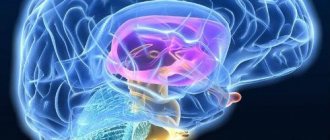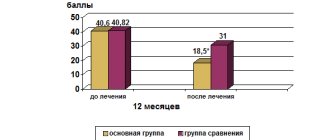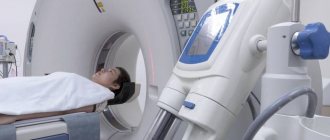The nervous system regulates every process in the human body. Its activity consists of sending, accompanying and returning impulses to various organs and tissues and back to the nerve centers. When the circulation of these signals is disrupted, various disorders occur, and micropolarization is one of the methods of their treatment.
How the method works
The essence of transcranial micropolarization is the effect of direct electric current
weak intensity (less than 1 mA) on individual brain structures. The current is comparable to the body’s own impulses, so this method is not at all aggressive and is suitable for patients even of a young age. Why is micropolarization of the brain prescribed to children? Indications and contraindications for the procedure and what is the goal of treatment?
| Age | Share in % |
| Adults (from 18 to 70 years old) | To 10% |
| Children (from 1 to 18) | Up to 57% |
| At what age is micropolarization of the brain performed in % | |
primary goal
— activate the working reserves of the brain and make it work more intensely and productively. The effect of current strengthens connections between nerve cells and restores normal regulation between them by purposefully changing the functional state of neurons.
With systemic (long-term) exposure, stimulation helps restore impaired or inhibited functions of the central nervous system.
There is another type of procedure, the effect of which is aimed at the spinal cord. It is called transverbetal and is aimed at restoring the motor functions of the body.
The therapeutic effect of direct electric current on brain cells.
We use a modified Western European technique, that is, it is more correct to call it tDCS (transcranial Direct Current Stimulation).
Does your child need this?
TDCS is one of the most promising and rapidly developing treatment and rehabilitation techniques in developed countries. In terms of the number of publications in scientific journals, it will give odds to any method without drug treatment. Active use in pediatric practice began in 2012. It was then that the implementation of the program began at the Prognoz medical centers. Until this time, scientists at research centers around the world have done a lot of work, which includes proving the safety and effectiveness of the method. At the moment, an extensive database has been formed that allows the method to be used in the treatment of children with an extremely wide range of pathologies. Our center staff monitors the latest publications every day and actively uses this information when drawing up treatment protocols.
The list of diseases for which the technique is successfully used: cerebral palsy (CP), autism spectrum disorder (ASD), epilepsy, motor/sensory alalia, tics, attention deficit hyperactivity disorder (ADHD), asthenoneurotic syndrome and many other disorders. The tDCS method is also used in adult practice.
What problem does this solve?
Many children have impaired function of certain structures of the brain and cerebellum, which are quite difficult, and often simply impossible, to influence with medication. The tDCS method allows you to act locally on precisely those structures whose functions are impaired. A direct electric current of minimal strength helps to improve the functioning of neurons and create new connections between them. If a child’s area, on the contrary, is overly excited (with focal epilepsy or in children with autism spectrum disorder), then this area can, on the contrary, be calmed using the technique, which will have a positive effect on the clinical manifestations of the disease.
How is it carried out?
A special cap with wires is placed on the child’s head. The space under the electrodes is moistened. During the procedure, the child does not experience any unpleasant sensations and is busy watching cartoons.
What are the results?
This method has begun to be actively used in the last decade. Numerous foreign studies have now been conducted and are actively being carried out, confirming the effectiveness of tDCS. The most promising is an integrated approach to carrying out these procedures, based on the application of the most modern knowledge. It is what is used in medicine that ensures clinical success and minimizes the number of side effects. The use of the tDCS technique significantly increases the effectiveness of any rehabilitation program. In particular, for children with autism spectrum disorder, the combination of tDCS and audio stimulation according to the Alfred Tomatis method is especially effective, since it allows not only to enhance the therapeutic effect, but also to avoid side effects, such as overstimulation of the child.
How many procedures are needed?
Regularity is extremely important for the successful use of this technique. As a rule, the doctor prescribes 10 procedures of 15-20 minutes each, which are carried out daily.
For what violations is the procedure prescribed?
The effectiveness of treating children with this method is very high
.
It is used for children who have behavioral disorders, motor dysfunction, and mental retardation. Treatment has a significant effect when:
- inhibition in neuropsychic development;
- Cerebral palsy (hyperkinetic, spastic, cerebellar, mixed forms of any severity);
- dysfunction of the speech apparatus;
- epilepsy;
- hyperactivity;
- attention deficit disorder;
- psychoemotional, psychosomatic, neurotic and neurosis-like disorders;
- excessive aggressiveness in children;
- enuresis (urinary incontinence) and psychogenic encopresis (fecal incontinence);
- panic fears and depressive disorders;
- neuroinfections;
- sensorineural hearing loss;
- visual impairment (nystagmus, strabismus, amblyopia);
- traumatic brain injuries and their consequences (dizziness, vegetative status, paresis, circulatory disorders in the brain, etc.);
- tension headaches;
- asthenic syndrome;
- oligophrenia (mild or 1st degree).
This method can also be used as a preventive method, in order to stimulate the “maturation” of brain processes. In children with the above diseases, a course of stimulation normalized sleep, leveled the psycho-emotional state and eliminated the negative symptoms of hyperactivity.
In victims of traumatic brain injuries, pain is reduced, lost functions are restored much faster and lesions are reduced.
At an early age, the vast majority of children suffer from chickenpox. You shouldn’t be too afraid of chickenpox - it leaves a strong immunity, and the course of the disease usually goes away without complications. Read more in the article: “chickenpox in children: symptoms and treatment.”
What is the essence of the procedure?
During the procedure, microcurrents act on a person - they are so small that they cannot harm a person. As a result of influencing certain areas of the brain, it is possible to achieve an improvement in the performance of the stimulated area.
To carry out micropolarization, electrodes are pinpointed onto the patient's head using a special cap, and the impact is carried out with a current of no more than 1 mA. For comparison, when carrying out the popular electrophoresis procedure, the current is 10-15 mA, and the electrodes are applied over a larger area.
The procedure is indicated in childhood; the use of micropolarization of the brain in children allows:
- Achieve activation of speech processes;
- Eliminate delayed psycho-speech development;
- Remove stuttering and tics;
- Coping with outbursts of aggression.
The technique is also in demand among the adult population. It is used during periods of recovery for patients after a stroke and helps reduce the severity of age-related disorders in the functioning of the brain and central nervous system.
Indications for micropolarization in adults:
- vascular diseases of the brain;
- rehabilitation period after a stroke;
- rehabilitation after traumatic brain injury;
- previous neuroinfection;
- epileptic seizures;
- "vegetative status";
- rehabilitation after brain or spine surgery;
- problems in the functioning of the visual and auditory systems;
- scoliosis.
When treating children with neurological problems, micropolarization has a much greater effect than in adults. This is due to the fact that children are still in the process of developing brain functions, which increases their compensatory and adaptive capabilities.
Who should not undergo treatment
Despite its safety, this therapy has a number of contraindications:
- acute inflammatory diseases (even greater stimulation of inflammation is possible);
- aggravated chronic diseases accompanied by elevated temperature;
- foreign bodies in the cranial bone;
- the presence of malignant brain tumors (can accelerate the development of cancer cells);
- cardiovascular failure and any heart pathologies;
- hypersensitivity to electric current;
- violation of the integrity of the scalp;
- excessive pigmentation or rash at the site where the electrodes are applied;
- connective tissue diseases;
- congenital stenosis.
Severe mental or genetic diseases, mental retardation, Down syndrome and autism are not contraindications to TCM, but therapy in such cases is ineffective and not very advisable. But some experts still recommend taking a course of micropolarization for at least the slightest shift
in a positive way.
Fragility and subsequent hair loss is a natural process associated with the constant renewal of the hairline. However, significant hair loss indicates problems in the child’s body. Read more in the article: “causes of brittle hair in children.”
3. Contraindications to the use of this technique
In addition to a number of positive and beneficial effects, this technique also has contraindications:
- Individual intolerance to electric current;
- Infectious or catarrhal diseases;
- Presence of tumors; increased body temperature;
- Systemic blood diseases;
- The presence of a foreign body in the skull or spine;
- Hypertension;
- Diseases of the cardiovascular system;
- Severe cerebral atherosclerosis;
- Skin defects in the scalp area.
In addition, it should be understood that micropolarization of the brain is not compatible with both various types of physiotherapy and diagnostic methods based on magnetic and electric fields.
Results from therapy
The effect is observed already from the first current stimulation, although the procedure is always prescribed in a course. The baby's relatives may not notice changes in the child's behavior or physiology, but they are clearly visible on the encephalogram
.
Therefore, it is recommended to undergo a brain examination to see the result confirmed by the study. The most obvious changes after the first session:
- Restoration of many psychological functions. The little patient is already adapting more quickly to the outside world, socialization is proceeding normally, attacks of nervousness and excessive hyperactivity are beginning to subside.
- Increased mental activity. The child perceives new information better, and creative inclinations begin to appear.
- Improved vision and hearing.
- Normalization of the speech apparatus. Stuttering and burr disappear or become less intense.
- Restoration of motor functions of the limbs.
- Normalization of the functioning of the pelvic organs. Enuresis and uncontrolled bowel movements disappear.
In some cases, this type of therapy is superior to drug treatment. The child becomes more sociable, active, and has no causeless mood swings. Doctors offer systemic micropolarization treatment to completely restore the mental and physical functions of the baby’s body.
Transcranial magnetic stimulation of the brain: reviews
Transcranial magnetic stimulation of the brain in Moscow is a relatively new and very promising direction in medicine. Using this method, it is possible to map different cortical representations, which in itself is extremely important for understanding the functional organization of the human brain, as well as the mechanisms of its control.
Transcranial magnetic stimulation of the brain makes it possible to accurately determine the boundaries of the location of various brain functions, for example, the cortical representation of visual analyzers, speech centers, and memory.
Reviews of transcranial magnetic stimulation among doctors in Moscow and other Russian cities are positive, since the procedure allows the development of new approaches to the rehabilitation of patients with neurological diseases.
The procedure is very accurate, informative, effective and painless. The technique allows many people to get rid of serious diseases.
Features of micropolarization
A physiotherapist, neurologist, psychotherapist, psychiatrist or speech therapist can refer for procedures
. The patient must first undergo a medical examination to determine possible contraindications and record the initial indicators (so that the dynamics can then be monitored).
It is often difficult for children with increased activity to sit through the entire procedure. It is necessary for the parents to explain to the child what will happen to him and why these manipulations are being carried out, why he must behave calmly and not be afraid. You can come up with some interesting game for him, where, for example, he will be an alien pilot with a bunch of wires on his head. Try it, it will help your baby spend time without getting bored!
During the session, a cap with electrodes is placed on the patient’s head, the other side of which is attached to the desired area of the head. Stimulation lasts about 40-50 minutes
. At this time, it is better not to make sudden movements or move away from the device, as this may lead to a change in the position of the electrodes. Often in the offices there are computers next to the machine, on which you can watch a movie or play during the procedures.
The average course consists of 8-12 procedures
which are carried out on an outpatient basis.
Depending on the result and the general condition of the patient, it is recommended to repeat the therapy after 3-6 months for a more systematic approach and a thorough effect. [media=
https://youtu.be/I7rgJuIjdiM
?t=14s]
More about the procedure
How is micropolarization of the children's brain carried out? Reviews of this technique are quite rare, as it is not widespread.
The procedure is not particularly complicated. A special helmet-cap with electrodes located on it is put on the patient’s head. It is part of a specialized device "Reamed-Polaris", specially designed for this procedure. The micropolarization method provides local effects on certain areas of the brain, due to which electrodes can be attached where pulse stimulation is needed.
During the procedure itself, the patient can actively go about his business (communicate, read a book, play). There are no unpleasant problems.
Stimulation time is about half an hour. This is the duration of one session, however, in order for any effect to be visible, several procedures must be carried out. The result is noticeable if the number of sessions required by micropolarization of the children’s brain is completed. Reviews usually note that success in treatment was observed after 8-10 regular procedures.
For some, according to reviews, 5-6 sessions were enough to get the first results, but it all depends on the individual characteristics of the brain.
Where can I get the procedure done?
The possibility of treatment depends on the availability of equipment and specially trained personnel in the clinic. There are two centers in Russia offering this service (the exact addresses can be viewed on the official websites):
- Moscow: Clinic of Restorative Neurology RUND;
- St. Petersburg: Research Institute of Neuropsychology named after. V.M. Bekhterev;
- Voronezh: clinic “Alternative Plus”.
For most people, treatment is expensive not only because of the cost of the procedure itself, but also because of the need to travel to another city. The lack of similar institutions in other large cities further hampers the development of this treatment method in Russia.










